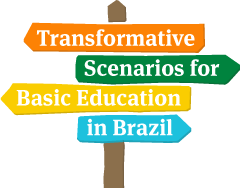Methodology
Scenarios are stories about what could happen in the future, not what will happen (forecasts) or what should happen (recommendations). The process of constructing scenarios is an exercise in suspending desires and set answers; of looking beyond forecasts and projections, and being open to considering a range of possible futures. These scenarios – the result of a collective process that brought together diverse perspectives – help to stimulate debate without the need for a predetermined commitment to any particular position. The scenarios allow us to deal with the fact that while we cannot predict or control the future, we can work to shape and influence it.
Transformative Scenario Planning is a creative and constructive way for actors from across a whole system to construct a set of stories of alternative possible futures. It is a way for them to get unstuck and to move forward on solving their tough problems.
Over the past 20 years, Transformative Scenario Planning has been applied in diverse circumstances and problematic contexts. It has been applied, for example, in the transition from apartheid in South Africa, in moments of great conflict in Colombia, in post-civil war Guatemala, and with the issue of drugs in the Americas at a time of great uncertainty and volatility.
The construction of scenarios follows a rigorous process, which is, at the same time, analytical and creative. The team begins by identifying the strategic agenda. In this case, these are the most important issues to consider when looking at Basic Education in Brazil. The group then defines the time horizon for the scenarios. Following this step, the group maps driving forces. For this project, these are the social, technological, environmental, economic, and political driving forces that influence Basic Education in Brazil. Any change in a driving force can have a significant impact on the issues identified as part of the strategic agenda. After identifying driving forces, the team classifies them into two axes – predictability and impact. In the scenario construction process, the high impact driving forces matter most. Once high impact forces are identified, the team differentiates between those that are highly predictable from those that are unpredictable. Predictable forces, called certainties, are in all the scenarios. The unpredictable forces, or uncertainties, differentiate one scenario from another.
When considering the certainties and uncertainties, participants found themselves with more than 50 possible scenarios, and faced the challenge of grouping and selecting the most important features. During the selection process, participants were guided by criteria to ensure that the scenarios would inspire transformative strategies, decisions, and actions. Scenarios should be:
- Relevant: illuminating current circumstances and concerns, and connected to current thinking and mental models;
- Challenging: making important dynamics that are invisible visible and raising questions about current thinking and mental models;
- Plausible: reasonable to believe that they could occur as they are logical and fact-based;
- Clear: accessible, memorable, and distinct from one another.
The construction of scenarios that are simultaneously plausible and challenging is not a simple task. Creating stories that others could have imagined or could imagine on their own, does not, in and of itself, justify a process like this, involving dozens of people and many hours of work. The value of the scenarios you will read lies in their ability to approach the limits of plausibility without, however, crossing over into the realm of the absurd or impossible.
After much debate, the team came up with four distinct scenarios. The next step was to imagine a series of events that would take place between 2015 and 2032 in order for each scenario to become reality by 2032. These “facts” were imagined, but otherwise based upon real data and cases that are presented throughout the report. Woven into the narratives are quotes (in italics) extracted from interviews conducted early in the process, which dialogue with the content of the narratives.
The Scenario Team named each of the four scenarios after birds found in Brazil, as a means of representing their characteristics and making them easier to remember. The idea behind selecting bird names was to endow the scenarios with a symbolic and neutral dimension that would not carry value judgments, but rather instigate and promote curiosity.
Following the workshops, the scenario report was written by the scenario editor in conjunction with the Reos Institute staff, who shared the document with the Scenario Team several times to receive feedback. The Center for Studies and Research in Education, Culture, and Community Action (CENPEC) then carried out a journalistic review, after which a final version of the document was created. The scenario report does not reflect the individual opinions of the Scenario Team members nor of the institutions in which they work.
Theory of Change
In partnership with MOVE – Evaluation and Strategy in Social Development, a Theory of Change was created for the Transformative Scenarios for Basic Education in Brazil project. The starting point for a Transformative Scenario Planning process is the recognition that there is an unacceptable and unsustainable situation, that a player in isolation cannot change the system, that direct changes are impossible or insufficient, and that there is the desire and will to change reality. The players involved in the project include the Convening Group, which maps out and invites selected people to participate in the process, a Funding Group, that contributes to the project financially and participates in the process, the interviewees (71), the Scenario Team (41), and the Facilitation Team. The process steps include:
- Selecting and convening the group;
- observation and in-depth understanding of the system;
- construction and validation of the set of scenarios;
- dissemination of and reflection on the scenarios;
- acting to transform the system.
The scenarios contribute to a long-term view and to the public debate, as well as inspire, stimulate and inform strategies, decisions and actions in the field of education in Brazil.


